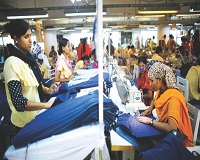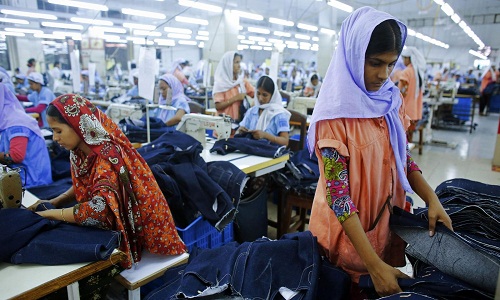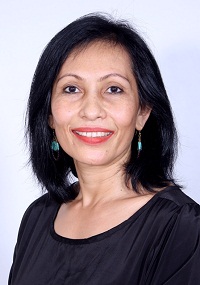FW
Australian wool prices are up 20 per cent. Australia controls 90 per cent of global fine-wool exports, where demand is being driven by Chinese wool mills and Italian garment makers. While wool has long been used by suit-makers, the surge in popularity is being driven by fitness and leisure clothing manufacturers looking for soft, durable and natural fibers.
But drought savaging Australia's east, where the bulk of the country's wool is produced, is hitting flock numbers, leading to lower production, threats to quality, and higher prices.
Like any commodity, wool has had its ups and downs, with sharp price spikes followed by troughs. This has prompted many overseas buyers to run down their stocks and wait for prices to fall. The wool industry in Australia has a big base of Chinese clients who mill the raw wool into fabric.
The threat of a fairly dramatic reduction in supply next year is underpinning the market. Many Australian farmers, meanwhile, are selling their older sheep to reduce their exposure to rocketing feed costs as the drought lingers, and to take advantage of high mutton prices. Lamb and sheep sales are running at around 15 per cent more than this time last year.
China will lower import tariffs on 1,585 goods including machinery, paper, textiles and construction materials from November 1, to reduce the costs for customers and companies even as its trade war with the US deepens. The combination of these and other tariff cuts this year will lower the tax burden on consumers and companies by about 60 billion yuan ($8.7 billion). The government has yet to detail how the general tariff cut will apply to US goods affected by retaliatory tariffs in the trade war.
The average import tax for some machinery will be reduced to 8.8 percent from 12.2 per cent, for textiles and construction materials to 8.4 per cent from 11.5 percent, and for paper and some other products to 5.4 per cent from 6.6 per cent, the radio station reported. This will lower the average most-favored nation tariff rate to 7.5 per cent from 9.8 per cent. China still has a higher average tariff rate than many developed economies. The US’ average applied MFN rate was 3.4 per cent in 2017.
"Nearly 7,000 RMG facilities in Bangladesh produce 16 per cent of all manufactured goods and employ 55 per cent of all workers in the manufacturing sector, says a report. Readymade garments account for 83 per cent of per annum exports. Bangladesh is heavily reliant on RMG exports and the signs can be alarming. Factors such as changes in trade relations, costs and access to shipping and logistical routes, raw material costs, and consumer tastes and attitudes can hamper growth of the industry and economy in turn."
 Nearly 7,000 RMG facilities in Bangladesh produce 16 per cent of all manufactured goods and employ 55 per cent of all workers in the manufacturing sector, says a report. Readymade garments account for 83 per cent of per annum exports. Bangladesh is heavily reliant on RMG exports and the signs can be alarming. Factors such as changes in trade relations, costs and access to shipping and logistical routes, raw material costs, and consumer tastes and attitudes can hamper growth of the industry and economy in turn. Garment workers’ unions are currently negotiating a raise in monthly minimum wages that is three times higher (Tk 16,000) than the current wage (Tk 5,300). The fact is Bangladesh’s export competency lies in its low cost labour and a wage hike would ultimately hamper trade dynamics.
Nearly 7,000 RMG facilities in Bangladesh produce 16 per cent of all manufactured goods and employ 55 per cent of all workers in the manufacturing sector, says a report. Readymade garments account for 83 per cent of per annum exports. Bangladesh is heavily reliant on RMG exports and the signs can be alarming. Factors such as changes in trade relations, costs and access to shipping and logistical routes, raw material costs, and consumer tastes and attitudes can hamper growth of the industry and economy in turn. Garment workers’ unions are currently negotiating a raise in monthly minimum wages that is three times higher (Tk 16,000) than the current wage (Tk 5,300). The fact is Bangladesh’s export competency lies in its low cost labour and a wage hike would ultimately hamper trade dynamics.
To evade over dependence on garments sector, the Bangladeshi government has launched an export diversification program in the manufacturing sector. The program is the product of a larger initiative aimed at increasing overall standard of living in Bangladesh with the goal of emerging as a middle-income country by 2021. Consisting of two five-year plans (FYP6 2010-2015 and FYP7 2016-2020), the program is supported in part through financing from the World Bank and covers everything from infrastructure to education to industry to women's empowerment.
If the government wishes to achieve its 2021 goal of manufacturing, which represents 90 per cent of exports, it would have to increase output substantially and secure a 28 per cent share of the GDP up from roughly 20 per cent. This is only possible if RMG production continues to achieve double-digit growth annually.
New economic policies
The reason behind such sustained growth has been industry-friendly policies, which include duty-free import of inputs, bonded warehousing facilities, back-to-back LC, rapid custom clearance. Part of the diversification plan is to utilise these same policies for the sectors whose export potential the government is seeking to boost.
inputs, bonded warehousing facilities, back-to-back LC, rapid custom clearance. Part of the diversification plan is to utilise these same policies for the sectors whose export potential the government is seeking to boost.
While companies who may be looking to source apparel from Bangladesh in the long-term will need to be mindful of the changing economic landscape, this push towards diversification doesn’t mean RMG industry will not get its due importance. In fact, one of the stated elements of manufacturing diversification is to increase the quality of existing sectors, one of which would be readymade garments. The incredibly favourable economic policies geared toward maximising the competitiveness of RMG exports are not so easily undone and could easily outweigh any added cost of a minimum wage increase.
Points to ponder
Meanwhile, RMG manufacturers are increasingly being pressured to bear more costs of production, taking responsibility for purchase of fabrics, development of samples, costs of couriers, and, in some cases the holding of stock. And to do so, there needs to be improvements at every step. The first improvement should be in planning and consistency of the buyer’s business with suppliers. Lack of accurate forecasting by customers can lead to large and unpredictable orders being placed at the lowest possible cost, with insufficient time for the manufacturer to produce the goods without the use of over-time or sub-contraction of orders. If consistent forecasts can be provided by the customer, the manufacturer is able to allocate necessary man-hours and capacity to fulfill the orders. Next, they need to create awareness about the importance of design and development. The costs of these developments are absorbed by suppliers and yet the rewards can be low, given the investment in time and resources required for the development of product.
Besides, buyers should be encouraged to support and incentivise development of sustainable business practices by suppliers. The future success of global garment supply chain hinges on the adoption of fully sustainable, transparent business practices, not only in Bangladesh, but around the world. There needs to be a sea change in the buying practices and that needs to be combined with a standardised, global set of criteria that is agreed by all customers for the manufacturing of garments, regardless of the origin of the goods being manufactured.
 A woman entrepreneur from North East-Ms. Jesmina Zeliang, who is also one of Members of Committee of Administration of EPCH has been nominated as President – Reception Committee- IHGF-Delhi Fair Autumn 2018. Her company M/s Heirloom Naga from Nagaland is increasing exports of cane and bamboo and artisanal handcrafted textiles from the North East since 1993 by participation in various Zeliang is actively engaged in empowering women from marginal communities and tribes in North East of India.
A woman entrepreneur from North East-Ms. Jesmina Zeliang, who is also one of Members of Committee of Administration of EPCH has been nominated as President – Reception Committee- IHGF-Delhi Fair Autumn 2018. Her company M/s Heirloom Naga from Nagaland is increasing exports of cane and bamboo and artisanal handcrafted textiles from the North East since 1993 by participation in various Zeliang is actively engaged in empowering women from marginal communities and tribes in North East of India.
Export Promotion Council for Handicrafts[EPCH], a nodal agency for promotion of exports of handicrafts from the Country to various destinations of the world, has been organising the IHGF-Delhi Fair for the last 24 years. IHGF-Delhi Fair Autumn is expected to generate a large amount of enquiries and orders.
Children’s fashion trade show Bubble is re-launching at Pure London for the February 2019 edition. Bubble will now be able to participate in the largest trade fashion event in the UK and experience the business opportunities this comprehensive offer will generate for buyers and brands alike.
Pure London represents women’s wear, men’s wear, footwear, accessories and young fashion. The show offers buyers from UK and international independents, multiples, department stores, etailers and mail order the opportunity to discover collections launching for the season ahead, attend catwalk shows and hear from their peers and other industry experts at valuable seminars and workshops.
Pure London is an ITE Group event. ITE was founded in 1991 and is now one of the world’s leading organisers of international exhibitions and conferences. ITE’s vision is to create the world’s leading portfolio of content-driven, must-attend events delivering an outstanding experience and ROI for customers. The group recently launched its Transformation & Growth program, which is designed to transform the company from a geographic-led business to a product-led business that focuses on market-leading events, wherever they are in the world.
ITE strives to run the best shows and offer the best service to its customers throughout the world regardless of location.
ISKO’s Earth Fit collection is made with raw materials like organic cotton, recycled cotton and recycled polyester from PET bottles. The collection reflects the brand’s longstanding focus on responsibility, innovation and citizenship. ISKO is the first denim mill in the world to obtain pre-certified Environmental Product Declarations (EPDs) for the life cycle assessment of all its 25,000 denim fabrics, meaning they are transparent about the environmental impacts of all the fabrics in the collection.
The EPDs are being used to create independently developed product category rules, which will help form a way, for the first time ever, to have standardized assessments for denim across the industry. Moreover, ISKO is a signatory of the Zero Discharge of Hazardous Chemicals program, which tackles the issue of hazardous chemicals in the textile industry.
With a unique eco-conscious mindset at the very heart of its approach, ISKO demonstrates how denim can make the difference in weaving a responsible fashion story by creating influential outfits. ISKO works with high-end fashion brands and designers who get inspired by its serious take on responsible innovation. The company has a production capacity of 250 million meters of fabric per year with 1,700 high-tech automated looms. ISKO has a global presence, with offices in 35 countries.
Selvedge Run trade show for quality garments and crafted goods with a focus on denim and heritage brands has been bought over by Panorama Berlin. With this acquisition, Panorama hopes to reach out to new target groups and create connecting synergies. After seven successful editions Selvedge Run feels it’s time to reach out to a new level and with the wide range and the logistic power of Panorama, Selvedge sees a good opportunity to unfold the full potential of its exhibitors and their brands and to open it to a wider audience.
Panorama Berlin debuted in 2013. It facilitates collaborating, networking and trading. It is an European marketplace for leading fashion brands. As the name suggests, it is an overview of the most important trends of the coming season.
The event provides a platform for buyers, dealers, trade visitors and media representatives from all over the world to meet and share various views with each other on the lifestyle and fashion industry. It has a select portfolio of top international fashion brands with business relevance. Every time there is a new brand mix and a strong focus on visitor services.
As per the trade magazine, Farmer’s Voice, Zimbabwe’s cotton output in 2018 marketing season increased 76 per cent year-on-year to 130,000 tonnes, from 70,000 tonnes last year, owing to increased government support to farmers. The output is the highest in nearly five years. The Reserve Bank of Zimbabwe expects the country to get around $85 million in foreign exchange through cotton exports this year. It has launched various free support initiatives under the ‘Presidential Inputs Scheme’ to help farmers increase their cotton production.
In 2011, Zimbabwe produced 268,000 tonnes of cotton, which fell to 135,000 tonnes in 2013-14 and further to 100,000 tonnes in 2014-15. In 2016, cotton yield was just 28,000 tonnes, the lowest since 1992. Due to government efforts, production increased to 70,000 tonnes in 2017.
Unifi Inc. has appointed Helen M Sahi as Vice President, Global Corporate Sustainability. In her new role, Sahi will lead, develop and drive the sustainability strategy and execution for Unifi, and will sustainability into the everyday fabric of the company’s business. Her responsibilities include: ensuring that Unifi’s sustainability strategy and practices are aligned with the company’s business objectives, and that all sustainability efforts are evaluated through a robust set of metrics.
With three decades of experience helping companies such as Avery Dennison Corp. and Bank of America set and achieve their sustainability strategies and goals, Sahi has, throughout her career, built effective partnerships with external organisations and NGOs to support and advance their sustainability efforts.
Through their brand partnerships, Unifi’s REPREVE® has become the leading global branded recycled fiber with a goal of transforming 30 billion plastic bottles into fibers by 2022, Sahi says.
Increasing demands for productivity and ever more complex applications, combined with the growing variety of materials, are key challenges faced by the sewing industry. In response to these challenges, Groz-Beckert will display a variety of special application needles (SAN®) – offering the perfect needle for every situation, tailored to the relevant application at the IFAI Expo (Industrial Fabrics Association International), in Texas, USA
The expo will be held from October 15-18, 2018 in the “Kay Bailey Hutchinson Convention Center” in Dallas. Groz-Beckert will participate with the Sewing product area at booth #2016.
The special application needle SAN® 5.2 delivers the best results for sewing technical textiles. The special shaft reinforcement increases the needle stability, for example, and the double coding in the point area improves the thread guidance in both linear and multi-directional sewing processes. For extremely fine loop and weave materials, on the other hand, special applications needles SAN® 10 and SAN® 10 XS are used.











